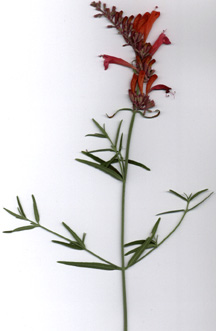| Plant of the Month: July 2003 |
Hummingbird Mints
|
| Seattle has certainly not the best climate to grow hummingbird mints. But I love them anyway, so planted 13 different kinds. Here is what I learned. |
| First, the different species of Agastache are said to number between 22 and 30; most are in the Southwestern U.S. or Mexico; a few are in eastern Asia. The name Agastache was made from the Greek agan, much, and stachys, an ear of wheat, and is translated "many-spiked" because these plants tend to bear numerous floral spikes. Though in the mint family (LABIATÆ or LAMMIACEÆ), and bearing square stems with opposite leaves, the various Agastache do not romp around in moist soil the way peppermint and spearmint (Mentha taxa) do. Most Agastache prefer well-drained soil, and full sun, with dryish conditions okay. The species tend to be clump-forming short-lived perennials. |
| Years ago, very few were cultivated. The most popular was A. Fœniculum, called Anise Hyssop, Lavender Hyssop, or Licorice Mint. It smells of fennel or anise, and bears broad leaves and bluish-purple flowers (white rarely). Its lovely bee- and butterfly-attracting flowers, warm fragrance, and ease of growth, made it beloved. |
| In recent years many other species and hybrids have been popular, especially southwestern species called hummingbird mints because their long-tubed flowers are full of nectar, and the red, orange and pink colors attract these restless little birds. |
| I am unaware that any Agastache are considered weedy. A few have been used modestly in medicine. Mostly people plant them for their beauty, fragrance, and to attract pollinators: bees (for honey), butterflies or hummingbirds. Some folks make tea from the leaves. |
| In general, the Agastache are easy to buy and plant, but I have found none live more than 4 years in my garden, and some live only one year. Two or three years seems the rule. However, I have been planting them in rich soil and not dividing them. If I plant them on leaner soil, sharply drained, and divide the clumps yearly, I may get them to be truly perennial --or at least some of them. Now that I have seen firsthand 13 kinds, I know what ones I am apt to prefer. |
| The chart below lists those kinds I have grown and supplies a few notes. If I could grow only one I think it would be 'Blue Fortune'. Factors that influence my decision are: robustness, scent, flavor of leaves and flowers (I am interested in them as salad flavorers), and beauty. |
The nursery I know that sells most, is High Country Gardens of Santa Fe, New Mexico.
Back |

A. rupestris scan by ALJ
|
|

